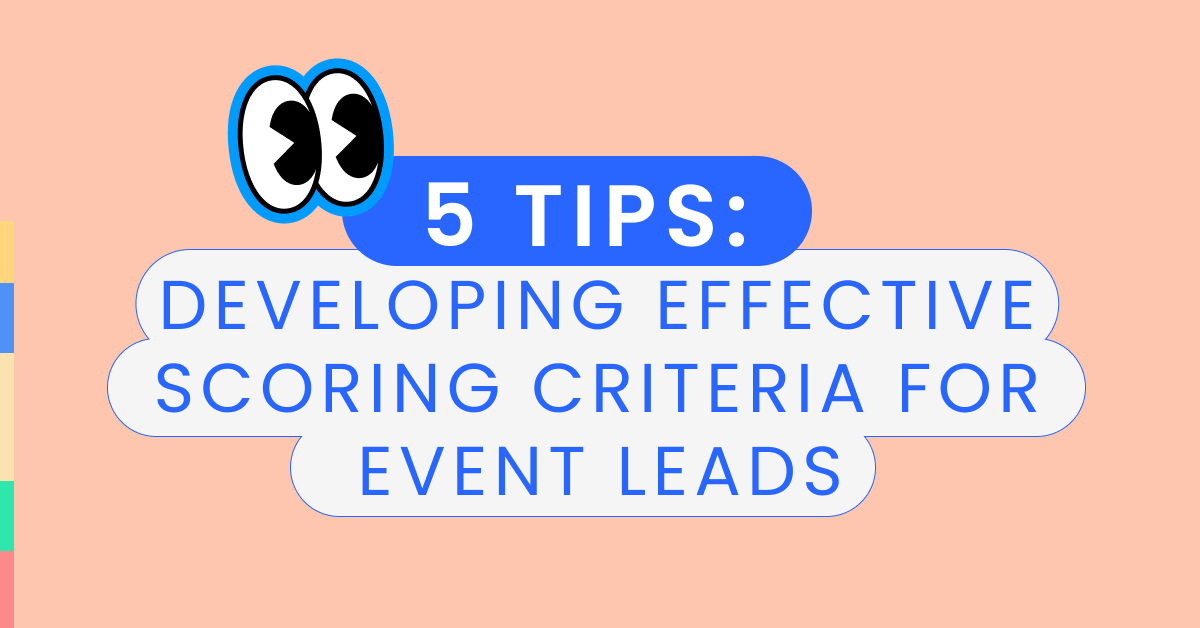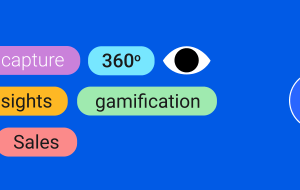Effective lead scoring criteria: Creating an effective lead scoring model requires understanding the unique set of criteria that best qualify leads for targeted follow-up strategies. According to MarketingSherpa, only 27% of leads generated are sales-ready, making it crucial to identify high-potential leads through well-defined scoring models. By establishing accurate scoring criteria, companies can refine their lead prioritization process, ensuring marketing and sales efforts are more focused and efficient.
In this article, we’ll explore the fundamental criteria used in developing lead-scoring models. We’ll discuss how engagement actions, demographic information, firmographic data, and other metrics can be used to prioritize and manage leads effectively. Additionally, we’ll offer practical tips on creating a scoring model that leads to better follow-up strategies and conversion rates.
Understanding Lead Scoring Criteria Development
Scoring criteria development is a critical component of an effective lead-scoring model. It involves identifying and quantifying various factors that indicate a lead’s readiness to engage or make a purchase. These criteria are essential for segmenting leads into categories based on their potential value and determining the most appropriate follow-up actions.
Defining Scoring Criteria
Scoring criteria are the specific characteristics or behaviors of leads that are quantified to prioritize and manage sales engagement. These criteria are divided into several categories, each providing unique insights into the lead’s profile and behavior:
- Demographic Information: Includes age, job title, industry, and other personal or professional descriptors.
- Firmographic Data: Pertains to organizational attributes like company size, industry sector, and annual revenue.
- Behavioral Data: Involves tracking interactions with your business, such as website visits, content downloads, and email engagements.
- Technographic Data: Focuses on a lead’s current technological environment, which can indicate readiness to adopt new solutions.
- Geographic Information: Considers the location of a lead, which can affect product or service relevance due to regional needs or regulations.
Importance of Scoring Criteria in Lead Evaluation
Scoring criteria help businesses efficiently allocate their sales and marketing resources by focusing efforts on leads most likely to convert. By scoring leads based on concrete data points, organizations can:
- Enhance Lead Segmentation: Differentiate leads based on their sales readiness or potential value, allowing for more targeted marketing strategies.
- Improve Conversion Rates: Focus on high-potential leads, which reduces the sales cycle and increases the likelihood of conversion.
- Streamline Sales Processes: Provide sales teams with prioritized leads, optimizing their workflow and improving overall efficiency.
- Adjust Marketing Strategies: Tailor content and communication based on the characteristics of high scoring, which leads to increased engagement and effectiveness.
Developing Effective Scoring Criteria
When developing scoring criteria, consider the following steps to ensure they align with your sales and marketing goals:
- Identify Key Lead Indicators: Determine which behaviors and characteristics are most commonly associated with successful conversions. Use historical data to identify trends and patterns.
- Assign Point Values: Each criterion should have a point value that reflects its importance relative to other criteria. High-value actions, such as scheduling a demo, should receive more points than lower-value actions, like clicking a marketing email.
- Create a Scoring Threshold: Establish a score threshold that leads must meet to be considered qualified. This threshold should be based on the typical scores of leads that have successfully converted in the past.
- Regularly Review and Adjust: Market conditions and business objectives change, so it’s vital to review and adjust scoring criteria periodically. This ensures the model remains relevant and effective.
- Test and Refine: Use A/B testing to compare different scoring models and refine your approach based on which leads to higher conversion rates.
Check out The power of lead scoring in managing multi-channel event marketing efforts
Incorporating these steps will help you develop a robust scoring model that identifies and prioritizes leads most likely to convert, optimizing both marketing and sales efforts. Next, we’ll dive deeper into the specific key criteria for scoring models, helping you.
Key Criteria for Scoring Models
Incorporating diverse criteria when constructing lead-scoring models allows for a more nuanced understanding of each lead’s potential value. Here, we discuss essential criteria types that should be considered to optimize your scoring system.
- Engagement Actions
Engagement actions are direct interactions that lead to your brand and offerings. These actions are crucial indicators of interest and intent.
- Email Interactions: Include actions like opening emails, clicking links, and the frequency of interactions. High engagement with email content typically signifies higher interest.
- Content Downloads: Downloads of whitepapers, case studies, and ebooks suggest a more profound interest in your solutions and can signify readiness to move further along the sales funnel.
- Webinar and Event Attendance: Participating in webinars and other virtual or physical events indicates a strong engagement level, meriting higher scores.
- Demographic Information
Demographic data provides insights into the lead’s identity and offers a basic framework for gauging how well they fit into your ideal customer profile.
- Job Title and Seniority: Understanding a lead’s position within their organization helps to assess their decision-making power.
- Industry and Company Size: These factors determine the relevance of your product or service to the lead’s specific professional environment.
- Firmographic Data
Firmographic data is similar to demographic data but relates to organizations instead of individuals. This data is particularly relevant in B2B sales.
- Company Revenue and Market Share: These indicators can help prioritize leads based on the potential deal size and the lead’s influence within the market.
- Industry Sector: Knowing the industry helps tailor your messaging and product offerings to meet sector-specific needs.
- Behavioral and Intent Data
Behavioral data tracks how leads interact with your marketing and sales channels, providing a dynamic measure of their current interests and intentions.
- Website Behavior: Page visits, duration on site, and interaction with specific content like pricing pages or product demos.
- Social Media Engagement: Interactions on platforms relevant to your industry can also provide a gauge of interest and engagement.
- Technographic Data
Technographic information relates to a company’s current technologies, which can inform compatibility and readiness for your product.
- Current Solutions: Identifying what solutions a lead currently employs can help understand their potential needs and how well your product could integrate or replace existing systems.
- Adoption Rates: The speed with which a company adopts new technologies may indicate its openness to innovation and new solutions.
- Geographic Location
Geography can influence lead scoring when regional factors impact the potential for business engagement.
- Market Accessibility: Some products or services are more applicable in certain regions due to legal, economic, or cultural reasons.
- Localization Needs: Understanding geographical variations can help tailor your approach to meet local expectations and requirements.
Creating Effective Lead Scoring Models
By integrating these criteria into your lead scoring models, you can more accurately determine which leads are most likely to convert, allowing for more focused and effective marketing and sales efforts. Here’s how to apply these criteria:
- Set Specific Weights: Assign numerical values to different criteria based on their predicted impact on lead conversion. For example, a demo request might score higher than a newsletter signup.
- Balance Scores: Ensure that no single criterion can overly skew the score. Balance must be maintained to keep the scoring fair and representative.
- Regular Updates: As your market environment and business objectives evolve, revisit and adjust your scoring criteria to remain aligned with current realities.
In conclusion, by carefully selecting and weighing diverse scoring criteria, businesses can build sophisticated lead scoring models that enhance the efficiency and effectiveness of their lead management processes. This approach ensures that sales teams are spending time on the most promising leads, optimizing both resources and outcomes.
For a comprehensive look at momencio’s lead scoring capabilities, explore our detailed article on advanced lead scoring mechanisms: how momencio prioritizes and enhances lead engagement.
Creating Effective Lead Scoring Models
To implement an effective lead scoring model, businesses must strategically develop and apply scoring criteria that accurately reflect the potential value of each lead. Here are some practical tips to help you build a robust lead scoring model that enhances your marketing and sales efforts.
1. Evaluate Engagement Actions
Engagement is a direct indicator of a lead’s interest and their position in the buying journey. It is crucial to differentiate between various engagement actions and assign appropriate scores based on their significance.
- Prioritize High-Value Interactions: Assign higher scores to actions that indicate strong buying signals, such as requesting a product demo or attending a detailed webinar.
- Score Repeated Engagements: A lead that repeatedly engages with your content or revisits your site is demonstrating sustained interest. Such behaviors should accumulate points, reflecting their growing engagement.
2. Consider Demographic Information
Demographic data helps in understanding whether a lead fits into your target market, making it a foundational aspect of scoring.
- Align with Buyer Personas: Develop scoring criteria that reflect the characteristics of your ideal customer profiles. For example, if decision-makers in your target market are typically senior-level executives, leads with such titles should receive higher scores.
- Use Negative Scoring: Not every demographic attribute is desirable. Consider using negative scores for attributes that disqualify leads as poor fits, such as wrong industry or job level too low to make purchasing decisions.
3. Weight Actions Based on Conversion Potential
Understanding which actions typically lead to conversions can help you assign weights more effectively within your scoring model.
- Analyze Conversion Data: Look at historical data to determine which behaviors and demographics have led to conversions. Use this analysis to assign higher weights to the most predictive behaviors.
- Dynamic Scoring Adjustments: As you gather more data, continuously refine how different actions are weighted. This dynamic approach allows the scoring model to evolve with changes in market behavior or business strategy.
4. Create a Tiered Scoring System
A tiered system helps in distinguishing between leads that are ready for sales contact and those that need more nurturing.
- Set Thresholds for Sales-Readiness: Define score ranges that categorize leads into cold, warm, and hot, or use similar categories that fit your sales process. This segmentation helps in applying appropriate marketing tactics and effectively timing sales outreach.
- Incorporate Time Decay: Some actions might lose value over time. For instance, a lead that visited your pricing page six months ago may be less interested now. Incorporate time decay in scores to reflect current lead warmth accurately.
5. Implement Regular Reviews and Feedback Loops
To ensure that your scoring model remains effective, regular reviews and adjustments are necessary.
- Collect Sales Feedback: Regularly consult with your sales team to get feedback on the quality of leads being passed on. This feedback can provide insights into how well the scoring model is working and what might need adjustment.
- Schedule Periodic Reviews: Set a regular schedule to review the scoring model and make adjustments based on new data, changing business goals, or feedback from sales and marketing teams.
- Use A/B Testing: Experiment with different scoring models to see which ones predict lead conversion most accurately. A/B testing can provide empirical data to support adjustments in scoring criteria.
By carefully evaluating engagement actions, considering demographic data, and weighing actions based on their conversion potential, you can develop a lead scoring model that effectively prioritizes leads for more targeted and successful marketing efforts. These models not only streamline the sales process but also enhance the overall efficiency of the marketing and sales funnel by focusing resources on the most promising leads.
Check out Personalized Lead Scoring: Implementation Strategies with Examples!
If you want to know more about momencio and what it does, we answer all the important questions in a free ebook. Download it here

Conclusion
Implementing an effective lead scoring model is crucial for streamlining your marketing and sales processes, ensuring that efforts are concentrated on the most promising leads. By developing comprehensive scoring criteria, businesses can optimize their strategies, enhance lead qualification, and ultimately drive higher conversion rates.
Here are the key takeaways from developing effective scoring criteria for event leads:
- Prioritize Accuracy and Relevance: The criteria used in your scoring model should accurately reflect the potential value and sales readiness of each lead. Regular updates and adaptations to the model ensure that it continues to align with current market conditions and business objectives.
- Align Marketing and Sales Efforts: A well-defined lead scoring model facilitates better alignment between marketing and sales teams. By clearly defining what constitutes a qualified lead, both teams can operate more cohesively, leading to improved outcomes and efficiency.
- Focus on High-Value Leads: By effectively scoring leads, your team can prioritize those with the highest potential for conversion. This prioritization helps in allocating resources more efficiently, thus maximizing the ROI of your marketing and sales efforts.
- Continuous Improvement and Adaptation: Lead scoring is not a set-and-forget process. It requires ongoing evaluation and refinement based on feedback from both sales and marketing teams, as well as a continuous analysis of performance data. This iterative process ensures the scoring model remains effective over time.
Ready to enhance your lead management and conversion rates? Leverage the power of detailed scoring criteria with momencio. Our platform offers advanced lead scoring capabilities that can transform your event lead management into a precise, efficient process. Discover how scoring criteria help improve targeted follow-up strategies—schedule a demo with us today and take the first step towards optimizing your event lead conversion strategies!
Interesting Facts from Research – effective lead scoring criteria
To further highlight the impact of well-executed lead scoring, let’s explore some intriguing facts and findings from recent research in the field of marketing automation and lead management:
- Increased Efficiency: Companies that excel in lead nurturing, which includes the use of lead scoring, generate 50% more sales-ready leads at a 33% lower cost per lead. This statistic underscores the efficiency gains that can be achieved when leads are accurately scored and appropriately nurtured.
- Improved Sales Productivity: Sales teams that focus on leads scored as high priority can see a productivity increase of up to 20%. This improvement is primarily due to sales reps spending more time with leads who are more likely to convert rather than sifting through unqualified prospects.
- Higher Conversion Rates: Organizations using lead scoring experience a 77% lift in lead generation ROI compared to those that do not use lead scoring. This boost is attributed to the targeted approach enabled by scoring, which aligns efforts toward the most promising leads.
- Better Alignment Between Marketing and Sales: Businesses with tightly aligned sales and marketing teams, facilitated by tools like lead scoring, see 38% higher sales win rates. This alignment ensures that both teams work towards common goals with a clear understanding of what defines a qualified lead.
- Adoption Rates and Market Trends: Over 68% of successful marketing professionals cite lead scoring based on content engagement and sales readiness as the most effective lead management strategy. This trend highlights the growing recognition of lead scoring’s critical role in enhancing engagement strategies.
FAQs – effective lead scoring criteria
- How often should scoring criteria be reviewed and updated?
- Scoring criteria should be reviewed regularly, at least once a quarter, to ensure they remain aligned with current marketing strategies and market conditions. More frequent reviews may be necessary if significant changes occur in the market or if new product launches are planned.
- Can lead scoring be automated?
- Yes, lead scoring can be fully automated using marketing automation platforms that integrate with your CRM system. Automation ensures that scoring is applied consistently and can update in real-time as leads interact with your content.
- What is the impact of lead scoring on lead conversion rates?
- Businesses that implement lead scoring typically see a significant improvement in lead conversion rates. According to industry studies, effective lead scoring can increase conversion rates by up to 30%, as it allows teams to focus on leads that are most likely to convert.
- How does lead scoring integrate with other marketing tools?
- Lead scoring should be integrated with your overall marketing automation and CRM platforms. This integration allows for a seamless transition of leads through the sales funnel, from initial capture to final conversion, with scoring updates influencing each stage of the journey.
- What are some common challenges with lead scoring?
- Common challenges include setting appropriate score thresholds, ensuring data quality, and aligning scoring with changing marketing strategies. Overcoming these challenges typically requires ongoing communication between marketing and sales, as well as regular data audits and model adjustments.
Continuing the Conversation
For those looking to dive deeper into the nuances of lead scoring and its integration with broader marketing strategies, consider exploring the following topics in future discussions or follow-up articles:
- Advanced Analytics Techniques: How machine learning and artificial intelligence are revolutionizing lead scoring models.
- Cross-Channel Marketing: The role of lead scoring in managing multi-channel marketing efforts and how it can provide a unified view of customer engagement across platforms.
- Customer Journey Optimization: Utilizing lead scoring to customize marketing messages based on the specific stages of the customer journey.
- Behavioral Prediction Models: Develop predictive models that not only score leads based on past behaviors but also predict future actions and potential conversion paths.
Additionally, to see how these advanced techniques can be directly applied to enhance your event strategies, revisit our earlier discussion on Optimizing your event strategy with lead scoring. This article provides practical insights into using lead scoring to refine your approach to event marketing, ensuring that each lead generated is maximized for potential conversion.














